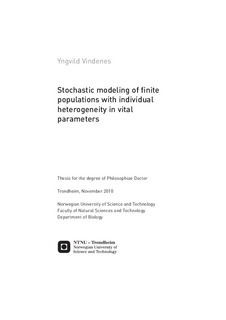| dc.description.abstract | Natural populations show large variation among individuals in patterns of survival and reproduction over time, that can often be associated with differences in state variables such as age, size or spatial location. Some of the variation is random, due to environmental fluctuations and inherent stochasticity in the processes of survival and reproduction. Several mechanisms can give rise to individual heterogeneity in natural populations, including spatial heterogeneity in the environment, maternal effects, cohort effects, and physiological differences. In this thesis I investigate how such heterogeneity affects properties of stochastic population dynamics, how it affects the fixation probability of slightly beneficial alleles, and how it influences effects of climate change on population dynamics. A demographic modeling framework for heterogeneous populations is developed based on stochastic matrix modeling and integral projection modeling, and I focus especially on (small) finite populations that are often of conservation concern.
One can never be sure to have detected all sources of heterogeneity in a natural population, and individual-based data are often not available. Therefore an important question is whether estimates of parameters describing long-term population dynamics and population viability will be biased due to hidden heterogeneity, and if so in which direction and to which extent. Results given in this thesis indicate that while estimates of the expected population growth rate are not affected, estimates of the demographic and environmental variance of the population growth will be biased if the reproductive value varies between individuals. These results highlight the importance of reproductive value in stochastic models of structured populations, as it is not differences in survival or reproduction per se that affect the long-term stochasticity in population growth, but differences in reproductive value.
Individual heterogeneity may affect the rate of evolution via the fixation probability of slightly beneficial alleles. Finding this probability is a classical problem in population genetics, dating from the work of Haldane in the 1920s. Here some earlier results are extended to include overlapping generations (individual heterogeneity) and stochastic fluctuations in a population with finite size (demographic stochasticity). The fixation probability of a slightly beneficial allele is shown to depend on the reproductive value of the individual(s) carrying the allele and the demographic variance of the population growth, in addition to the selective advantage of the allele and the population size. The reproductive value and demographic variance both depend on individual heterogeneity and can reflect general life history properties of the population. If the reproductive value of the individual(s) carrying the allele is low and the demographic variance is high, the probability of ultimate fixation will be low.
In the presence of climate change individual heterogeneity can influence predictions of future population dynamics, because the effect of climatic variables on vital parameters can depend on individual state. Both the mean and variability of climatic variables are predicted to change in the future, so it is also important to assess their relative influence on population dynamics. Using data from a population of long-lived eurasian oystercatchers (Haematopus ostralegus) and a stochastic stage structured matrix model, we investigated effects of mean and variability in an important climatic variable (winter temperature) and predicted future population dynamics for different climate scenarios. The mean and variability of winter temperature had opposite effects on survival and fecundity, and the median time to extinction was most sensitive to changes in vital parameters of breeders in high-quality habitats. The population dynamics were overall more sensitive to changes in survival rates than in fecundity, in line with predictions from life-history theory for long-lived species. We hypothesize that general life history properties may be used to predict effects of changes in mean and variability in climatic variables. This study illustrates that if we want to understand how climate change affects future population dynamics, it is crucial to consider individual-level processes. | nb_NO |

